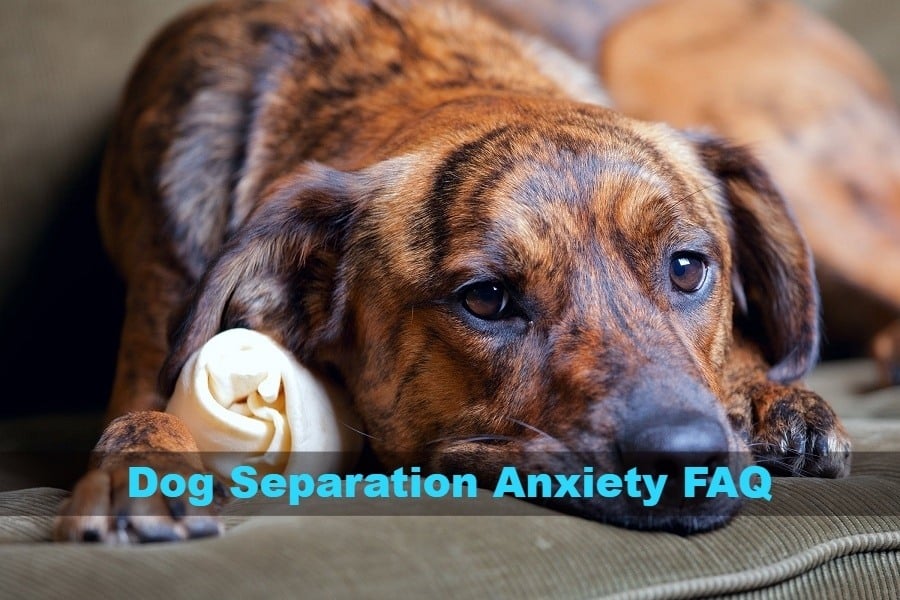Dogs are fiercely loyal animals and they love nothing more than being by the side of their faithful owner.
It’s because of this attachment that they develop to us that they’re more likely to exhibit signs of separation anxiety whenever we’re not around, and it’s surprisingly common among dogs of all breeds.
Separation anxiety usually exhibits itself in behaviors that are destructive and disruptive, and many people put it down to their dog just being misbehaved.
People will often punish their dog due to this behavior which doesn’t help their anxious condition, and without understanding the root cause and how to treat it, things will never get better.
The best approach for dog owners is to learn more about separation anxiety, how to spot it, and what might be causing it.
As something that many dogs go through in their lives at some point, it’s part of being a responsible owner to know how to help them out.
What Is Dog Separation Anxiety?

Separation anxiety is a common occurrence in dogs that have an attachment to their owners.
Whenever the owner leaves them alone, they will get stressed out and start feeling anxious wondering where they have gone, and then act out in negative ways.
Owners of dogs with this condition might notice their pet starting to act distressed before they even leave the house because their dogs can sense that they plan on going somewhere.
Other dogs won’t start to worry until you’re actually gone, so a lot of these behaviors won’t be witnessed until you get home and see the destruction.
Most researchers have found that dogs with anxiety-related problems are more likely to be male.
Did You Know
Too often, people misjudge their dog’s poor behavior for something else and think they’re just being ‘naughty’. This leads to punishment or people wanting to give their pets away, which is never a pleasant experience.
The symptoms of separation anxiety are more than just a little bit of barking or tearing up some shoes, they can be quite severe and very distressing for your pet to go through.
The Symptoms of Dog Separation Anxiety

Dog separation can cause a range of symptoms for your pet and they’re often confused for something else, like a lack of training or just being disruptive.
Here are some common symptoms to look out for that could indicate your pet is suffering from separation anxiety, according to the ASPCA.
Barking, howling and whining
A dog that barks or whines persistently at nothing in particular and only when their owner has gone away is usually a trigger of this condition.
Destructive behavior
Chewing, digging, or destroying random objects that happens when their owner isn’t around can be a sign of separation anxiety.
Urinating and defecating
Dogs that wait until you leave the house to defecate or urinate may be suffering from separation anxiety. You can take them out to the bathroom before you leave and see if they still go while you’re away.
Running away
If your dog regularly tries to escape whenever you leave the house, usually in an attempt to find their owner. The result can be injury from scratches, getting stuck in fences or boundaries, or even being picked up by local animal authorities.
Pacing
A dog with this condition may start walking in a particular pattern, like in a circle of back and forth, whenever they’re feeling stressed.
Common Causes That Lead to Pet Anxiety
Due to the close connection that dogs have with their owners, there may be no single thing that triggers this separation anxiety other than not wanting to be without them. However, consider these common causes if you think that something has changed recently to lead to this behavior.
There may be times when a misdiagnosis occurs due to other factors that seem like separation anxiety.
Poor house training, effects of medication, medical problems, and boredom may all be possible causes and should be ruled out before you assume it’s this specific condition
Ways to Treat the Condition

The first thing to do if you suspect separation anxiety is taking your pet to the vet, as they will be able to give a better diagnosis. If they believe that this is what they’re suffering from, the most effective method is something called counterconditioning.
Counterconditioning replaces the fearful and bad feelings they get when you leave with a good thing.
You might give them a special chew toy as you go or give them a healthy treat to entertain them. When you get home, remove the toy or food so that they start to associate it with you not being around.
Other additional tactics you can try include calming down your departures and arrivals, taking them outside for more exercise before you go anywhere or mix up your departure routine so they can’t get used to it. If you find all of these things aren’t working, you may need to resort to extreme measures, like going to visit an animal behaviorist for advice.
Taking Care of Your Dog’s Mental Wellbeing
Being left alone can be a high-stress situation for some dogs, and not all of them react the same way to it.
Separation anxiety is a very real and common condition for dogs of all ages, but with some basic knowledge on what it looks like and how we can treat it, we’ll make sure our dogs never have to suffer from these feelings again.


